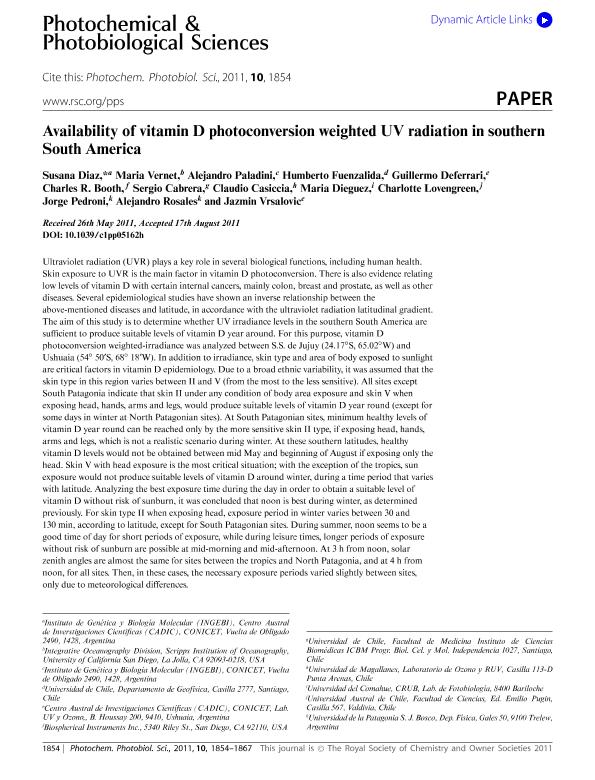Artículo
Availability of vitamin D photoconversion weighted UV radiation in southern South America
Diaz, Susana Beatriz ; Vernet, María; Paladini, Alejandro Alberto
; Vernet, María; Paladini, Alejandro Alberto ; Fuenzalida, Humberto; Deferrari, Guillermo Alejandro
; Fuenzalida, Humberto; Deferrari, Guillermo Alejandro ; Booth, Charles R.; Cabrera, Sergio; Casiccia, Claudio; Dieguez, Maria del Carmen
; Booth, Charles R.; Cabrera, Sergio; Casiccia, Claudio; Dieguez, Maria del Carmen ; Lovengreen, Charlotte; Pedroni, Jorge; Rosales, Alejandro; Vrsalovic, Jazmin
; Lovengreen, Charlotte; Pedroni, Jorge; Rosales, Alejandro; Vrsalovic, Jazmin
 ; Vernet, María; Paladini, Alejandro Alberto
; Vernet, María; Paladini, Alejandro Alberto ; Fuenzalida, Humberto; Deferrari, Guillermo Alejandro
; Fuenzalida, Humberto; Deferrari, Guillermo Alejandro ; Booth, Charles R.; Cabrera, Sergio; Casiccia, Claudio; Dieguez, Maria del Carmen
; Booth, Charles R.; Cabrera, Sergio; Casiccia, Claudio; Dieguez, Maria del Carmen ; Lovengreen, Charlotte; Pedroni, Jorge; Rosales, Alejandro; Vrsalovic, Jazmin
; Lovengreen, Charlotte; Pedroni, Jorge; Rosales, Alejandro; Vrsalovic, Jazmin
Fecha de publicación:
08/2011
Editorial:
Royal Society of Chemistry
Revista:
Photochemical and Photobiological Sciences
ISSN:
1474-905X
Idioma:
Inglés
Tipo de recurso:
Artículo publicado
Clasificación temática:
Resumen
Ultraviolet radiation (UVR) plays a key role in several biological functions, including human health. Skin exposure to UVR is the main factor in vitamin D photoconversion. There is also evidence relating low levels of vitamin D with certain internal cancers, mainly colon, breast and prostate, as well as other diseases. Several epidemiological studies have shown an inverse relationship between the above-mentioned diseases and latitude, in accordance with the ultraviolet radiation latitudinal gradient. The aim of this study is to determine whether UV irradiance levels in the southern South America are sufficient to produce suitable levels of vitamin D year around. For this purpose, vitamin D photoconversion weighted-irradiance was analyzed between S.S. de Jujuy (24.17°S, 65.02°W) and Ushuaia (54° 50′S, 68° 18′W). In addition to irradiance, skin type and area of body exposed to sunlight are critical factors in vitamin D epidemiology. Due to a broad ethnic variability, it was assumed that the skin type in this region varies between II and V (from the most to the less sensitive). All sites except South Patagonia indicate that skin II under any condition of body area exposure and skin V when exposing head, hands, arms and legs, would produce suitable levels of vitamin D year round (except for some days in winter at North Patagonian sites). At South Patagonian sites, minimum healthy levels of vitamin D year round can be reached only by the more sensitive skin II type, if exposing head, hands, arms and legs, which is not a realistic scenario during winter. At these southern latitudes, healthy vitamin D levels would not be obtained between mid May and beginning of August if exposing only the head. Skin V with head exposure is the most critical situation; with the exception of the tropics, sun exposure would not produce suitable levels of vitamin D around winter, during a time period that varies with latitude. Analyzing the best exposure time during the day in order to obtain a suitable level of vitamin D without risk of sunburn, it was concluded that noon is best during winter, as determined previously. For skin type II when exposing head, exposure period in winter varies between 30 and 130 min, according to latitude, except for South Patagonian sites. During summer, noon seems to be a good time of day for short periods of exposure, while during leisure times, longer periods of exposure without risk of sunburn are possible at mid-morning and mid-afternoon. At 3 h from noon, solar zenith angles are almost the same for sites between the tropics and North Patagonia, and at 4 h from noon, for all sites. Then, in these cases, the necessary exposure periods varied slightly between sites, only due to meteorological differences.
Palabras clave:
Vitamin D
,
Photoconversion
,
Ultraviolet Radiation
,
South America
Archivos asociados
Licencia
Identificadores
Colecciones
Articulos(CADIC)
Articulos de CENTRO AUSTRAL DE INVESTIGACIONES CIENTIFICAS
Articulos de CENTRO AUSTRAL DE INVESTIGACIONES CIENTIFICAS
Articulos(INGEBI)
Articulos de INST.DE INVEST.EN ING.GENETICA Y BIOL.MOLECULAR "DR. HECTOR N TORRES"
Articulos de INST.DE INVEST.EN ING.GENETICA Y BIOL.MOLECULAR "DR. HECTOR N TORRES"
Articulos(INIBIOMA)
Articulos de INST. DE INVEST.EN BIODIVERSIDAD Y MEDIOAMBIENTE
Articulos de INST. DE INVEST.EN BIODIVERSIDAD Y MEDIOAMBIENTE
Citación
Diaz, Susana Beatriz; Vernet, María; Paladini, Alejandro Alberto; Fuenzalida, Humberto; Deferrari, Guillermo Alejandro; et al.; Availability of vitamin D photoconversion weighted UV radiation in southern South America; Royal Society of Chemistry; Photochemical and Photobiological Sciences; 10; 12; 8-2011; 1854-1867
Compartir
Altmétricas



